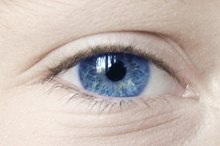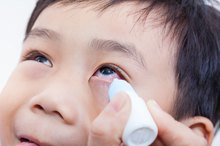Is It Okay to Swim With a Stye?
An infected oil gland swells with fluid, creating a sty on the eyelid. This swollen, red bump is sensitive to touch and can occur in individuals of all ages, although certain behaviors increase the risk of experiencing a sty. For example, sleeping with eye makeup on or not thoroughly washing your hands before changing contact lenses raises the risk of infection. The danger of swimming with a sty depends on the water environment and your own protective measures.
Good Goggles
Wearing properly fitted goggles prevents your sty from contaminating water. The fluid inside a sty contains bacteria capable of infecting someone else's eye duct if her fingers or face come in contact with the sty. Additionally, the hard structure of swimming goggles protects your sensitive eyelid from flying elbows or kicking feet that might burst the sty, causing further infection. Without protective goggles, a swimmer whose hand accidentally brushes against your sty can infect his own tear duct by rubbing his eye immediately afterward. Test your goggles for leakage before swimming by tightening them around your head and dunking your face in a sink of water.
- Wearing properly fitted goggles prevents your sty from contaminating water.
- The fluid inside a sty contains bacteria capable of infecting someone else's eye duct if her fingers or face come in contact with the sty.
Chlorine Complications
Can You Swim Wearing Contacts and Goggles?
Learn More
Goggles create a barrier between your sty and the chlorinated water of a swimming pool. However, those with sensitivity to chlorine can experience itching and burning eyes by breathing the air inside an indoor pool. Scratching or rubbing your eyes in response to this irritation could rupture your sty, leaving your eyelid painfully raw and agitated. Those without chlorine sensitivity who wear goggles consistently should not experience problems while swimming in a chlorinated pool.
- Goggles create a barrier between your sty and the chlorinated water of a swimming pool.
- However, those with sensitivity to chlorine can experience itching and burning eyes by breathing the air inside an indoor pool.
Risk to Others In a Swimming Pool
The high chlorine content of a properly managed communal swimming pool makes contaminating others nearly impossible while swimming with a sty. However, protect your sensitive eye in a crowded or active swimming pool by wearing goggles. Avoid swimming in kiddie pools or private pools with a sty on your eye. The chlorine levels of private pools are much lower than a communal or municipal pool, making it easier for bacteria from your sty to survive in the water and infect others. Kiddie pools contain minimal water and no chlorine, making contamination even more likely between individuals.
- The high chlorine content of a properly managed communal swimming pool makes contaminating others nearly impossible while swimming with a sty.
- The chlorine levels of private pools are much lower than a communal or municipal pool, making it easier for bacteria from your sty to survive in the water and infect others.
Lakes and Ponds
Should You Swim in a Pool with an Open Abrasion?
Learn More
Swimming in a lake or pond with a sty is less safe than a chlorinated pool or the ocean because the water is stagnant and fresh. A body of non-chlorinated, stagnant water at lukewarm temperature keeps the bacteria alive even after you swim away. A sty that was accidentally ruptured or scratched open while swimming in warm, stagnant water could become painfully infected by naturally occurring bacteria like Pseudomonas aeruginosa. Like pools, swimming in close proximity to others without goggles in a lake or pond increases the chances of infecting others and sustaining injury to your eyelid.
- Swimming in a lake or pond with a sty is less safe than a chlorinated pool or the ocean because the water is stagnant and fresh.
- Like pools, swimming in close proximity to others without goggles in a lake or pond increases the chances of infecting others and sustaining injury to your eyelid.
Related Articles
References
- Women and Children's Health Network: Parenting and Child Health -- Styes
- Nemours' Foundation: Water Safety
- Pediatric Associates of Plano: Stye (Hordeolum)
- Michigan Department of Public Health: Chlorine Fact Sheet
- Novak-Bilić G, Vučić M, Japundžić I, Meštrović-Štefekov J, Stanić-Duktaj S, Lugović-Mihić L. Irritant and allergic contact dermatitis - skin lesion characteristics. Acta Clin Croat. 2018;57(4):713–720.
- Centers for Disease Control and Prevention. Rashes. Reviewed May 4, 2016.
- Centers for Disease Control and Prevention. Parasites - Cercarial Dermatitis (also known as Swimmer's Itch). Reviewed October 22, 2018.
- Rossetto AL, Da Silveira FL, Morandini AC, Haddad V, Resgalla C. Seabather's eruption: report of fourteen cases. An Acad Bras Cienc. 2015;87(1):431-6. doi:10.1590/0001-3765201520130468
- Chaumont A, Voisin C, Sardella A, Bernard A. "Interactions Between Domestic Water Hardness, Infant Swimming and Atopy in the Development of Childhood Eczema." Environmental Research. 2012 Jul;116:52-7. DOI: 10.1016/j.envres.2012.04.013.
- Gomà A, de Lluis R, Roca-Ferrer J, Lafuente J, Picado C. "Respiratory, Ocular and Skin Health in Recreational and Competitive Swimmers: Beneficial Effect of a New Method to Reduce Chlorine Oxidant Dervatives." Environmental Research. 2017 Jan;152:315-321. DOI: 10.1016/j.envres.2016.10.030.
- Khodaee M, Edelman GT, Spittler J, et. al. "Medical Care for Swimmers." Sports Medicine Open. 2016 Dec; 2: 27. DOI: 10.1186/s40798-016-0051-2.
- Salvaggio HL, Scheman AJ, Chamlin SL. "Shock Treatment: Swimming Pool Contact Dermatitis." Pediatric Dermatology. 2013 Jul-Aug;30(4):494-5. DOI: 10.1111/pde.12017.
Writer Bio
Christina Bednarz Schnell began writing full-time in 2010. Her areas of expertise include child development and behavior, medical conditions and pet health. She holds a Bachelor of Arts in international relations.









